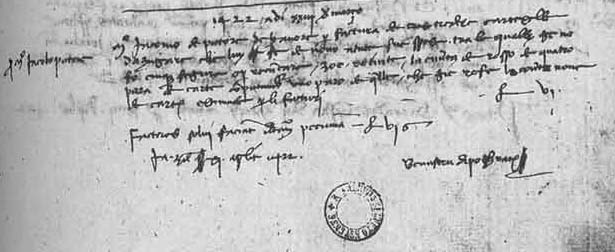The first Note about Playing Cards in Ferrara
The account books of Ferrara have provided us with lots of entries about playing cards. In them we find the first reference to Imperatori cards in 1423, the first mention of Trionfi cards in 1442, the important entry about a 70 card-game in 1457 and the first note about Tarocchi cards in 1505. Also we find there the mysterious entry about a present to Bianca Maria on the 1st of January 1441, which might be the key to the origin of the 5x14-Trionfi-deck. And some more of the of the documents, that you find exposed in our chapter about the use of the name Trionfi.The first entry, which relates to playing cards in these books, is from 1422 and it is unclear, what is talked about. Is it about a general repairing action of some decks with some not understandable and confusing details, as Ortalli in The Prince and the Playing Cards suggested, or is it about a simple "updating action", in which a 4x13-deck is changed to a 5x13-deck?
With the Pierpont-Morgan-Bergamo-deck we've - eventually - another example for an "updating action" (from a 5x14-deck to a 4x14 + 20-deck), the Ferrarese entry from 1422 strengthen the argument there. A deciding role plays the first word in the fourth line. Does it mean, as in the description below suggested, "para", implying "pack (of cartes)" or is it an expression of "suits"? Or could, as there are not much doubts, that it really means "para", this word also have been used for something like "suit"? Boiardo uses for suit "colora", colours, a word still in use in European languages for suits, but it is not clear, if this word was already in use in the year 1422.

| 1422, adi XXIII de marco, Maistro Iacomo depictore de havere per factura de tredexe cartexelle da zugare che luy fe de novo a tute sue spexe, tra le qualle ge ne fo cinque figure, o per recuncare, zoe retinte la cuverta de rosso de quattre para de carte, computantdo una para de quelle che gie refe le cuverte nove de carte extimade per li factura L. VI. Factures solvi faciant dictam pecuniam L. VI. Iacobus Zilfredus scripsit XI aprilis 1422 Benastru d'Ipocratibus |
Ortalli writes: "In a register of Este Camera Ducale payments we find that a certain "Iacomo depictore" was due 6 lire for "13 new playing cards entirely re-made at his expense, including 5 figure cards, and for repairing , that is, repainting red the covers of four packs, the cost of the new covers being valued as one pack by the factors".
"Iacomo depinctore" is identified as Iacobo di Bartolomeo Sagromoro, a painter, who was very often employed by the d'Este court. He worked "on friezes, the decorations of ceilings, walls, tracery as well as court carriages, pennons, crests, flags, nuptial trunks, harnesses, pattern for fabrics and embroidery".
Ortalli interprets the passage: "In the 1422 document he (Iacopo Sagramoro) had been given a twofold task: he had to repair 4 packs of playing cards to be painted red on the back, and make 'ex novo' 13 'cartexelle', five of which were figures (and therefore the other 8 numerales). It is difficult to say whether these new cards were or were not an independent pack; they may even have been required for some game with only 13 cards of which we have lost all trace. I would surmise it is more likely that the new cards were intended to replace missing or irreparably damaged cards in the four packs to be repaired, and since the backs of all the cards were repainted the new cards would not stand out from the old ones." In context to this Ortalli relates to another entry from 1423, in which Sagramoro also was used as card-restorator: "... he had to repair the back, fix the corner, glue down where necessary and make two new cards." We will meet Sagramoro at other occasions: although being a painter of probably only minor value, he became the great Trionfi artist of the early time.
In my opinion the entry from 1422 has another possibility of interpretation: Sagramoro made 13 new cards to update an already existing 4x13-deck to a 5x13-deck. This deck had 5 figures (probably the normal 3 court cards + a figurative drawn "ace" and "ten" and 8 numbers (2 - 9). He had to repaint the back of the old 52 cards to make them look in the same way as the new cards, otherwise the opponents in game could decipher some information about the content of the hand of the other players. Decks with a 5th suit are already known from the document of Johannes von Rheinfelden from the year 1377 (a 5x13-deck is mentioned), although some informations are suspected to be added at a later time (perhaps in 1429). In the case, that the special passage in the Johannes von Rheinfelden text was added later, the above quotation might be the oldest entry about a deck with a 5th suit. However, it is not impossible, that Ortallis interpretation was correct.
(autorbis)